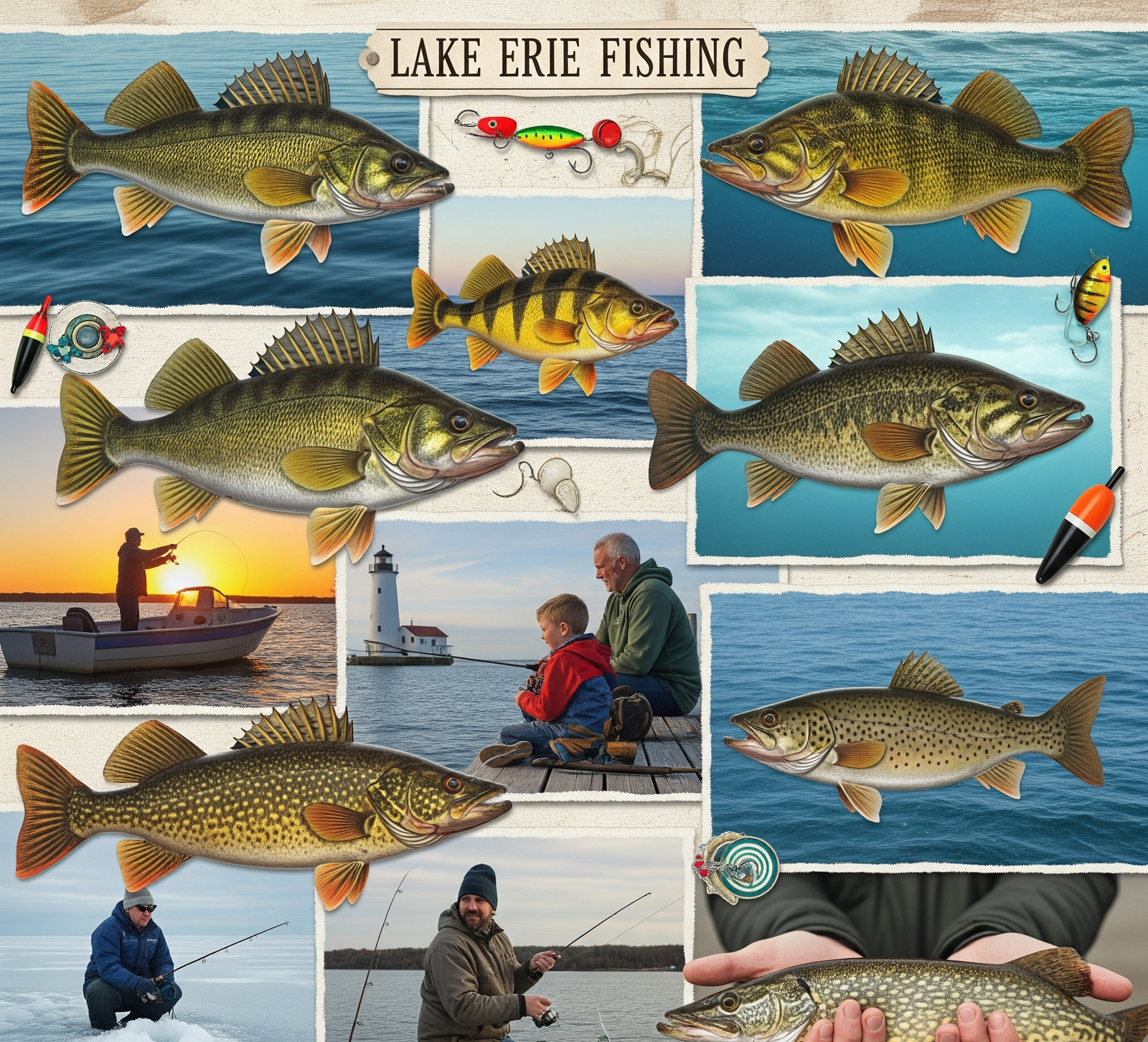Lake Erie isn’t just another Great Lake; it’s a true fishing paradise. Spanning four U.S. states and touching Canada, this freshwater giant draws anglers from all walks of life. Many beginners come chasing their very first catch, while seasoned pros hunt for trophies. Families often hit the water simply hoping to reel in a few fish for a classic lakeside fry.
If you’ve been wondering which Lake Erie fish species are worth your time and when the best seasons are to catch them, you’re in the right spot. Here in this guide, we’re going to take you through the top catches, when to bite best, and a couple of tried-and-true tips that will assist you in landing them. Whether you’re reserving a charter or taking out your own boat, you’ll depart with advice you can use in actuality out on the lake.
Why Lake Erie Is a Fishing Hotspot
Lake Erie may be the shallowest of the Great Lakes, but that doesn’t take away from its incredible fishing potential. Its waters are full of variety reefs, rocky shorelines, deep basins, and river mouths—all of which create the perfect environment for different kinds of fish to thrive. Thanks to this mix of habitats, Lake Erie has earned a reputation as one of the most productive and exciting freshwater fisheries in all of North America.
Here’s why Erie stands out:
- It’s often called “The Walleye Capital of the World.”
- Millions of yellow perch swim here, making it one of the top spots to limit out in fall.
- The lake offers world-class smallmouth bass fishing, especially in the eastern basin.
- Seasonal runs bring steelhead and lake trout close to shore.
- It’s accessible, so you don’t need to be a pro or own the fanciest boat to enjoy a good day of fishing here.
Many anglers say Erie feels less intimidating than other big lakes because of how approachable the fishing can be. If you look at a Lake Erie fish species chart or guide, you’ll quickly see just how diverse this fishery really is.
Walleye: Lake Erie’s Superstar
Why Walleye Matter
If Lake Erie had a mascot, it would be the walleye. They’re aggressive, delicious, and plentiful. Each year, millions are caught across the lake, especially in Ohio and Michigan waters. A lot of beginner’s struggles at first to figure out trolling speeds, but once they do, the bite feels almost unstoppable.
Best Seasons
- Spring (April–June): Walleye move onto shallow reefs to spawn, especially in the western basin.
- Summer (July–August): Fish push east into deeper waters. The central and eastern basins shine here.
- Fall (September–November): The big ones feed hard before winter, and trolling crankbaits becomes the go-to.
Where to Target Them
• Western Basin: Around islands like Put-In-Bay, Kelley’s Island, and reefs like Toussaint.
• Central Basin: Off Cleveland, Lorain, and Ashtabula.
• Eastern Basin: Clear, deep water near Erie, PA, and Dunkirk, NY.
Techniques That Work
• Spring: Jigging blade baits or hair jigs around reefs.
• Summer: Trolling crankbaits, spoons, or crawler harnesses with planer boards.
• Fall: Large stick baits like Reef Runners or Husky Jerks.
Pro Tip: Walleye may be finicky when it comes to trolling speed. Success is found by many starting at 1.5 mph and working their way up through 2.2 mph until the bite becomes active.
Pro Tip: Walleye can be picky about trolling speed. Many anglers find success starting around 1.5 mph and adjusting up to 2.2 mph until the bite turns on.
Yellow Perch: The Family Favorite
Why Perch Matter
Ask any Ohio family their favorite fish to catch and eat, and you’ll hear “perch” every time. They’re schooling fish, so once you find them, the action can be fast. And the fillets? Crispy, golden, and some of the best freshwater eating you’ll ever have. Perch fishing is also perfect for kids since the bites come quick once you’re on the school.
Best Seasons
- Late Summer (August): Schools start forming.
- Fall (September–November): Prime time. Limits are common, and the action can be nonstop.
Where to Find Them
- Western Basin: Sandusky Bay, Maumee Bay, and around the islands.
- Central Basin: Between Lorain and Geneva-on-the-Lake.
- Eastern Basin: Deeper waters near Erie, PA, and Dunkirk, NY.
Techniques That Work
- Anchor or drift over schools using dropper rigs.
- Use live emerald shiners they’re perch candy.
- Keep baits just off the bottom and be ready for subtle bites.
Pro Tip: Perch bites can be so light that a lot of beginners miss them at first. Keep tension on your line and don’t wait too long to set the hook.
Among all Lake Erie fish species, perch stand out as the most family-friendly option because of their constant action and excellent table fare.
Smallmouth Bass: The Bronze back Brawler
Why Bass Matter
Lake Erie is consistently ranked in the top five smallmouth lakes in North America. These fish are fighters; pound for pound, they might be the toughest customers in the lake. Many anglers find the fight of a smallmouth more exciting than landing a big walleye, simply because of their sheer power.
Best Seasons
- Late Spring (May–June): Pre-spawn and spawn. Fish are shallow, aggressive, and easy to find.
- Summer (July–August): They move deeper but stay active.
- Fall (September–October): Bass feed hard, smashing moving baits.
Where to Target Them
- Eastern Basin: Rocky shorelines and reefs near Buffalo, NY, and Erie, PA.
- Central Basin: Break walls and harbors near Cleveland.
Techniques That Work
- Spring: Tubes, jerk baits, and swimbaits.
- Summer: Drop-shot rigs, Ned rigs, and deep-diving cranks.
- Fall: Spinnerbaits, chatter baits, and other reaction baits.
Pro Tip: Always handle bass carefully. Erie’s smallmouth fishery remains world-class only because anglers protect it. Wet your hands, support their belly, and release them quickly.
Smallmouth are one of the crown jewels among Lake Erie fish species, treasured not just for their fight but for the sustainable catch-and-release culture around them.
Steelhead: The Silver Bullet
Why Steelhead Matter
Steelhead are rainbow trout that migrate between the lake and rivers. They’re famous for wild runs and high jumps. Many anglers say landing one is the highlight of their entire season.
Best Seasons
- Fall (September–November): Steelhead gather at river mouths before running upstream.
- Winter (December–February): They’re in tributaries and bite well on warmer days.
- Spring (March–April): Post-spawn fish drop back into the lake and can be caught near shore.
Where to Target Them
- Lake Shore: Near river mouths like the Grand, Chagrin, and Conneaut.
- Tributaries: Streams in Ohio, Pennsylvania, and New York all get strong runs.
Techniques That Work
- Trolling small spoons or crankbaits.
- Casting spinners or jigs under floats near river mouths.
- Drift fishing with spawn sacs or beads in rivers.
Pro Tip: Steelhead love water temps between 50 and 60°F. Many anglers check temps first thing before even launching the boat.
Lake Trout: The Deep-Water Heavyweight
Why Lakers Matter
Not everyone targets lake trout, but those who do know they’re special. They live deep, grow big, and fight with raw power. Lakers hug bottom structure, making them tricky to locate but worth the effort when you finally hook into one.
Best Seasons
- Spring (April–June): Cool water brings them closer to shore.
- Fall (September–October): They move shallower again as temps drop.
Where to Target Them
- Eastern Basin: Deep structure off Dunkirk, NY, and Erie, PA.
- Canadian Waters: Reefs and drop-offs near Long Point.
Techniques That Work
- Slow-trolling spoons or cowbells.
- Vertical jigging with heavy jigs when you mark fish deep.
Pro Tip: Many anglers use sonar to find humps and baitfish schools before they even start fishing for lakers.
Lake trout may not be as abundant as other Lake Erie fish species, but for trophy hunters, they remain a must-try target.
Bonus Species Worth Mentioning
Lake Erie isn’t just about the big five. You’ll also bump into:
- Channel Catfish: Best in bays and rivers, especially at night with cut bait.
- White Bass: Great spring action in May and June.
- Freshwater Drum (Sheepshead): Found everywhere and a blast for kids.
- Northern Pike and Muskie: Lurk in weedy bays. Spring and fall are your best bets.
This variety is exactly why anglers love coming back year after year because the Lake Erie fish species list is so diverse and exciting.
Planning Your Trip: Season by Season
Each season on Erie has its own rhythm. Knowing what’s biting when can make or break your trip:
- Spring: Walleye spawn in the shallows, smallmouth is aggressive, and steelhead runs can still be strong.
- Summer: Prime time for walleye and perch. Smallmouth stay active in deeper water, and stable weather makes this a comfortable season to fish.
- Fall: A feeding frenzy with walleye, perch, and bass going crazy, while steelhead stage near tributaries.
- Winter: Tough on the open lake, but tributary steelhead fishing can be excellent. Ice fishing is possible in certain areas if conditions are safe.
Many anglers find fall to be the most rewarding time, while beginners often enjoy summer for its stable weather and easier bite. Checking a Lake Erie fish species chart before you go can help you plan even better.
Experience, Expertise, and Trust: Choosing a Charter
Desire the highest success rate? Hire a local captain or charter. A quality captain has information about where the fish are, what they’re biting on, and knows how to adjust when things change.
What to look for:
- Licensing and insurance
- Years of experience on Erie
- Up-to-date fishing reports
- Positive reviews from other anglers
What you’ll get:
- All gear and safety equipment
- Real-time coaching
- Fish cleaning or local referrals
- Insider knowledge on regulations
Tip: Some captains supply bait while others don’t. Always ask what’s included before booking.
Ethical Fishing: Protecting Erie for the Future
Lake Erie stays productive because anglers respect it. Do your part:
- Follow size and bag limits.
- Release fish you won’t eat.
- Handle fish gently.
- Don’t litter at the launch or on the water.
Whether you’re chasing perch or targeting trophy walleye, keeping the lake healthy ensures that all Lake Erie fish species thrive for generations to come.
Final Thoughts: Why Lake Erie Belongs on Your Bucket List
So, why target Lake Erie species of fish? Simple: variety, abundance, and nonstop action. In the morning you can jig for walleye, catch some perch for lunch, and in the evening, you can chase smallmouth or steelhead. You might even get lucky and catch a lake trout or some muskie. Plan your trip at the right time of year, bring the right equipment, and take local advice you are well on your way to having a cooler full of fish and a memory roll full of pictures.
Many anglers who fish Erie once find themselves coming back year after year. From sunrise on the dock to that final picture with your catch, Erie isn’t just a lake. It’s an experience.
If you’re prepared to have the time of your life with the best of all Lake Erie fish species, a local charter can be the deciding factor. Local captains who know the water can put you right on top of the fish, whether a trophy walleye or a dinner bucket full of perch. A safe bet is Sir Walleye Charters, where experienced guides provide all the essentials for a fun-filled day on the lake. It’s an easygoing, trouble-free manner to experience Erie, ideal for both beginners and experienced anglers.


